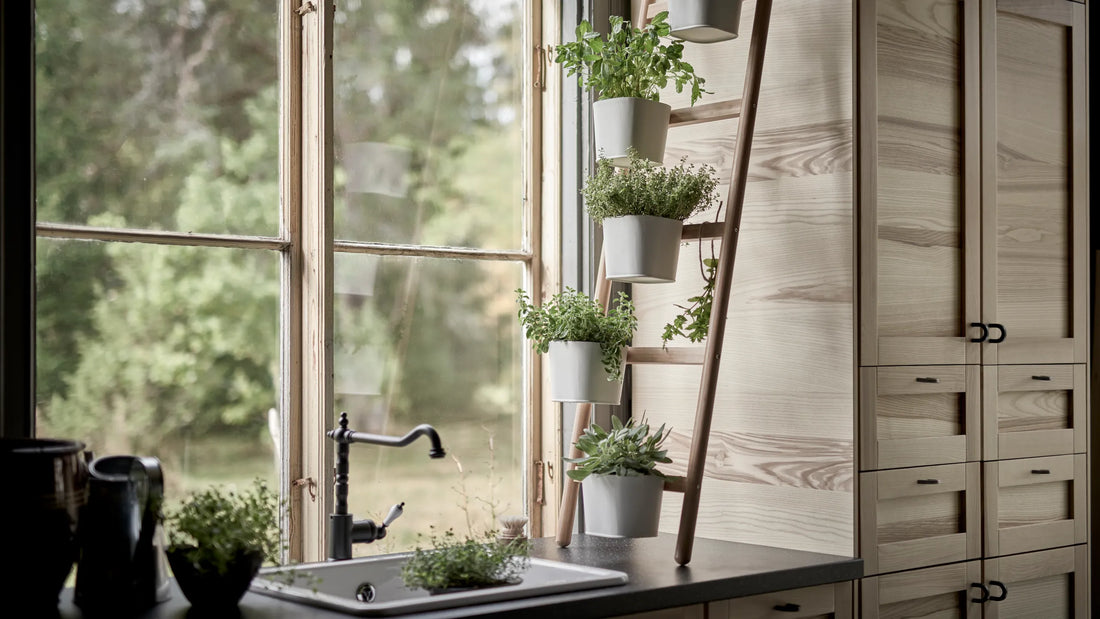
How to Create a Kitchen Herb Garden: Decor and Function in One
1. Choose the Right Location
The first step in creating a kitchen herb garden is selecting the ideal location. Consider these options based on your space and sunlight availability:
- Windowsills: Perfect for small spaces, a sunny windowsill is an excellent spot for growing herbs like basil, chives, and parsley.
- Countertop Planters: Use countertop planters or herb pots that fit neatly on your kitchen counters or islands.
- Wall-Mounted Shelves: For a space-saving solution, install wall-mounted shelves or hanging planters to keep your herbs within easy reach.
- Hanging Baskets: If you have limited counter space, hanging baskets can be a stylish and practical option.
2. Select Your Herbs
Choose herbs that you frequently use in your cooking and that thrive in your chosen location. Common kitchen herbs include:
- Basil: Great for pesto and Italian dishes, basil loves warmth and plenty of sunlight.
- Mint: Perfect for teas, salads, and garnishes, mint thrives in cooler conditions and needs regular watering.
- Rosemary: Ideal for roasting meats and vegetables, rosemary prefers well-drained soil and full sunlight.
- Chives: Excellent for adding a mild onion flavor to dishes, chives are low-maintenance and grow well in containers.
- Parsley: Versatile in many recipes, parsley needs moderate sunlight and regular watering.
3. Choose the Right Containers
Selecting the right containers is crucial for the health of your herbs and the aesthetics of your kitchen. Consider the following:
- Pots: Choose pots with good drainage holes to prevent waterlogging. Terracotta or ceramic pots add a classic touch to your kitchen.
- Planters: For a more modern look, opt for sleek metal or plastic planters. Consider self-watering planters to make maintenance easier.
- Containers: Repurpose containers like mason jars, tin cans, or wooden crates for a rustic or DIY touch.
4. Use Quality Potting Mix
A good potting mix is essential for healthy herbs. Use a high-quality potting mix that provides good drainage and aeration. Avoid using garden soil, as it can be too dense and may not drain well in containers.
5. Implement a Watering Routine
Herbs require consistent watering to thrive, but overwatering can lead to root rot. Follow these tips:
- Monitor Moisture: Check the soil moisture regularly. The top inch of soil should be dry before watering again.
- Watering Schedule: Adjust your watering schedule based on the herbs’ needs and your kitchen’s humidity levels.
6. Add Fertilizer
Herbs benefit from periodic feeding to promote healthy growth. Use a balanced, water-soluble fertilizer or organic options like compost. Follow the recommended application rates to avoid over-fertilizing.
7. Incorporate Decorative Elements
Your kitchen herb garden can also be a stylish addition to your decor:
- Labeling: Add attractive labels to your pots to easily identify your herbs. Chalkboard labels or decorative plant markers work well.
- Arrangements: Group pots in a visually appealing arrangement on your countertop or shelf. Mix different heights and container styles for a dynamic look.
- Themed Containers: Use containers that match your kitchen’s decor style, whether it’s farmhouse, modern, or vintage.
8. Harvest and Use Fresh Herbs
Regularly harvesting your herbs encourages new growth and ensures you have fresh ingredients for your meals. Snip leaves or stems as needed, and use them in your cooking for the best flavor.
9. Address Common Issues
Keep an eye out for common issues like pests or diseases:
- Pests: Check for signs of pests like aphids or spider mites. Neem oil or insecticidal soap can help manage infestations.
- Diseases: Ensure good air circulation and avoid overwatering to prevent fungal diseases.
10. Enjoy Your Herb Garden
Take pleasure in the beauty and functionality of your herb garden. Enjoy the fresh flavors in your cooking, and appreciate the vibrant greenery it adds to your kitchen space.
Conclusion
Creating a kitchen herb garden is a wonderful way to blend function with decor. By choosing the right location, selecting suitable herbs, and incorporating stylish containers, you can enhance both the look and utility of your kitchen. With regular care and maintenance, your herb garden will provide fresh ingredients and a touch of natural beauty to your home.
Ready to start your kitchen herb garden? Follow these tips and transform your kitchen into a fragrant, functional oasis of fresh herbs!

